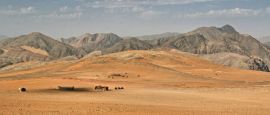Witness the impressive spectacle of the Kalandula Waterfalls, one of the largest by volume anywhere in Africa. Located in the country’s north, the falls are spread along 400m (1,312ft) and fall over 100m (328ft) from forested clifftops. The views are particularly mighty at the end of the rainy season when the Lucala River that feeds them is in full flood.
Angola things to see and do
Tourist offices
Address: Largo 4 de Fevereiro, Palácio de Vidro, CP 1242, Luanda, Angola
Tel: (2) 310 899.
www.angola.org
It was at Soyo that the Portuguese explorer Diogo Cao was the first European to set foot on land in what is now Angola and placed a stone padrao (or standard). Five centuries on, the padrao still stands on the tip of a beautiful peninsula which is also home to sea turtles.
The many forts that dot Angola’s coastline give a real sense of the country’s history as a Portuguese colony. The largest and most famous is Luanda’s Fort Sao Miguel, built in 1576 to protect the fledgling city and serve as a slave depot. It now contains the Museum of the Armed Forces.
Palmeirinhas beach offers magnificent scenery and a long, deserted beach approximately 45 km (28 miles) south of Luanda, while in the opposite direction Santiago beach is known for its fishing. To swim, the beaches of Luanda’s Ilha peninsula are a better bet, and just five minutes from the capital’s heart.
Kissama (or Quiçama) National Park is currently the only functioning national park in the whole country, and is within easy reach of Luanda. Thanks to a reintroduction programme, the park is home to an increasing variety of wild animals, including elephants and the rare black palanca antelope, which can only be found in Angola.
Less frenetic than the capital, Benguela maintains its cool colonial charm, making the most of its bay side location. The Governor’s Palace, facing the long sandy beach, is one of the best examples of colonial architecture in the country, while plenty of public spaces provide shade for taking in the sights and sounds.
The newly refurbished Benguela railway follows an old trade route inland to the Democratic Republic of Congo. Comprising 67 stations and 42 bridges, it is one of the longest rail journeys in Africa, and a great way to see Angola’s hinterland while interacting with its people.
To the south of Angola, close to the city of Lubango, lies Tundavala Gap. Views extend for miles from among the rim of cliffs known as the Serra da Leba escarpment, which marks the end of the Bié plateau that divides Angola into high and lowland.
Ever improving Luanda deserves more than just a quick rest stop on arrival from the international airport. It’s the city’s atmosphere that draws you in, with a pleasant Atlantic Ocean location and historic churches and architectural gems lining almost every street of the lower city. One of the more curious attractions is the towering Mausoleum of Agostinho Neto, the country’s first president: love it or hate it, you can’t ignore it.
Gain a historical understanding into Angola’s role in the Atlantic Slave Trade at the Museum of Slavery, 25 km (16 miles) along the coast from Luanda. The museum is located near a 17th-century chapel in which slaves were baptised before boarding ships for the New World.
Do you have any Feedback about this page?
© 2025 Columbus Travel Media Ltd. All rights reserved. No part of this site may be reproduced without our written permission, click here for information on Columbus Content Solutions.








 You know where
You know where